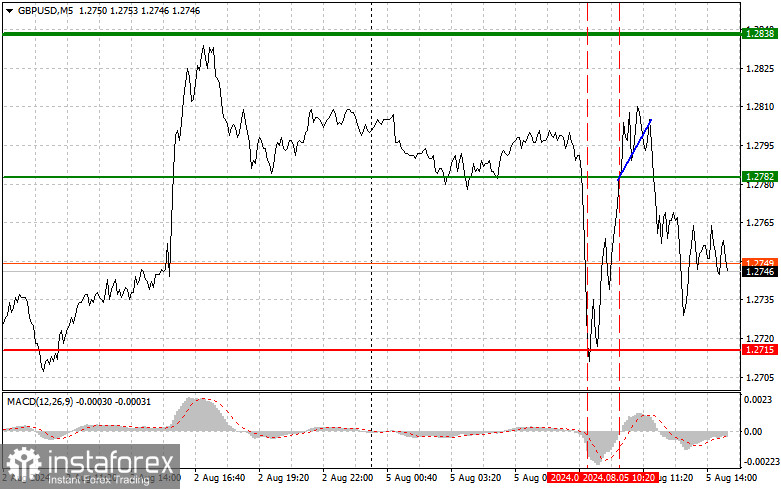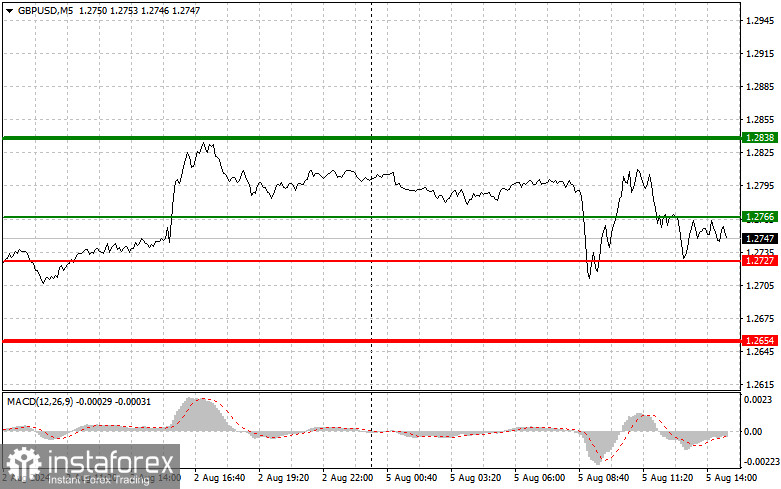Trade analysis and tips for trading the British pound
The price test at 1.2715 came when the MACD indicator had significantly moved down from the zero mark, limiting the further downward potential of the pound, so I decided not to sell at the lows, fearing a market reversal. After some time, a price test at 1.2782 coincided with the beginning of the MACD's upward movement from the zero mark, allowing entry into the market to buy the pound. However, pressure on the pair returned after an upward movement of 20 points. Strong data from the U.K. services sector saved the pound, but it was insufficient to establish a new upward trend. Ahead of us are important statistics on the U.S. service sector activity index and the composite PMI index, which includes manufacturing activity. In case of poor statistics, pressure on the U.S. dollar will increase, strengthening the pound. Strong statistics will limit the upward potential of the pair. Regarding the intraday strategy, I plan to act based on the implementation of scenarios #1 and #2.

Buy signal
Scenario #1: I plan to buy the pound today upon its reaching the entry point around 1.2766 (green line on the chart) to rise to 1.2838 (thicker green line on the chart). At 1.2838, I will exit from buying and open sales in the opposite direction (anticipating a movement of 30-35 points in the opposite direction from the level). Growth of the pound today can only be expected after weak U.S. data. Important! Before buying, ensure the MACD indicator is above the zero mark and is just starting its upward movement.
Scenario #2: I also plan to buy the pound today if the price at 1.2727 is tested twice consecutively when the MACD indicator is in the oversold area. This will limit the pair's downward potential and lead to a market reversal upwards. An increase to the opposite levels of 1.2766 and 1.2838 can be expected.
Sell signal
Scenario #1: I plan to sell the pound today after updating the level of 1.2727 (red line on the chart), leading to a rapid decline in the pair. The key target for sellers will be the level of 1.2654. I plan to exit from selling and immediately buy the pound in the opposite direction (anticipating a movement of 20-25 points in the opposite direction from the level). Sellers will only become active after strong U.S. data. Important! Before selling, ensure that the MACD indicator is below the zero mark and is just starting to decline from there.
Scenario #2: I also plan to sell the pound today if the price at 1.2766 is tested twice consecutively when the MACD indicator is in the overbought area. This will limit the pair's upward potential and lead to a market reversal downward. A decrease to the opposite levels of 1.2727 and 1.2654 can be expected.

What's on the chart:
- The thin green line – the entry price, where you can buy the trading instrument.
- The thick green line – the presumed price, where you can set Take profit or fix profits yourself, as further growth above this level is unlikely.
- The thin red line – the entry price, where you can sell the trading instrument.
- The thick red line – the presumed price, where you can set Take profit or fix profits yourself, as further decline below this level is unlikely.
- MACD indicator. When entering the market, it is important to be guided by the zones of overbought and oversold.
Important: For novice traders in the Forex market, it is necessary to be cautious when making market entry decisions. It is best to stay out of the market before major fundamental reports are released to avoid being caught in sharp fluctuations in the exchange rate. If you decide to trade during the release of news, always place stop orders to minimize losses. You can quickly lose your deposit without placing stop orders, especially if you do not use money management and trade in large volumes.
And remember, successful trading requires having a clear trading plan, such as the one I have presented above. Making spontaneous trading decisions based on the current market situation is a losing strategy for a day trader.





















